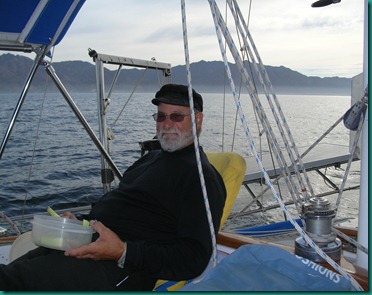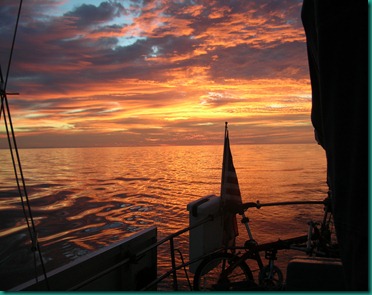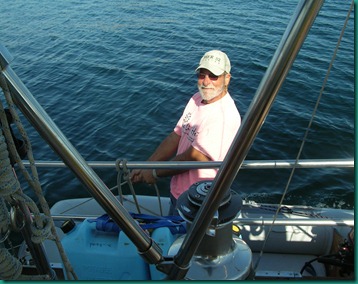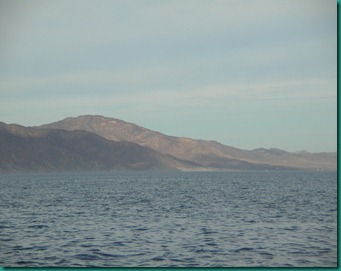As a head’s up, this blog entry is long and has very few pictures. This is not a deliberate attempt to bore you to death, but it may have that unintended effect for which I apologize. I have left it complete as it is for my own purposes – many of the details of what transpired during our “two-day” crossing are described more completely here than in our log. A ship’s log is actually considered to be a legal document, and its careful maintenance by the skipper is a legal requirement. I consider this blog entry to be a clarifying addition to the log, and a copy of it will be added to the log.
Chapter 1
We originally planned to leave Mazatlan, bound for La Paz, on Friday, March 11. You will perhaps recall that that was the day of the immense earthquake near Japan and the subsequent tsunami. The Port Captain for Mazatlan closed the port. This meant that no boats could leave or enter the harbor. So we paid for another night’s slip fee at the marina and planned to leave on Saturday. Saturday morning was foggy, so we waited about an hour past our originally planned departure time of 9:00 am. During this hour, Larry replaced the domestic water pump because it had chosen this moment to die. We just happened to have a spare! We left around 10:00 and got outside the marina breakwater about a half an hour later where the fog was much worse. This was unexpected, but by then it was practically too late to turn around and wait. The marina access channel is long and narrow, and it dog-legs. Turning around seemed ill-advised. So off we went in the fog, using our radar and keeping the brand new sound horn handy.
In the fog, we crossed paths with a large motor yacht that somehow didn’t show up on the radar. We “saw” many fishing boats somewhere out in the fog, but didn’t actually see any other boats before the fog lifted around 12:00. The wind was light, so we were motoring. The trip was nice and boring – flat water, not much wind.
The Skipper kicks back for a snack:
One of our last sunsets at sea for a while:
Sunday morning, Skipper made us fried potatoes and eggs for breakfast. Yum! Around noon, the Admiral went downstairs to use the facilities and reported a squeaking sound coming from the engine room. The Skipper checked it out, and had me turn off the engine. He checked out the v-belt which drives the alternator and cooling water fresh water pump. The belt seemed to be wearing excessively. He re-tensioned the belt, and we re-started the engine. The squeaking started back up almost immediately, so we turned the engine off again. The wind had come up by now, so we sailed. We decided we would use the engine only at the end of the trip to help us through the San Lorenzo channel and down to the anchorage in La Paz.
Making progress in your intended direction against headwinds is very challenging in a sailboat, especially when you are constrained by geographic features, like islands, that you don’t want to run into. We sailed back and forth across the Sea of Cortez for about 24 hours and realized we were not making enough northerly progress to get around Isla Cerralvo. A glance at the chart convinced us to tuck into Bahia de Los Muertos. Meanwhile, Muggs designed a temporary fix for the v-belt problem. The alternator appeared to be causing the problem with the belt. So I suggested we remove it and install in its place the spare which requires a regulator to properly charge the battery system. Instead of wiring the new alternator’s battery charging connections, Larry left them unconnected. The alternator acted as a place-keeper in the belt path so that the fresh water pump would work. We had solar panels to charge the batteries and a generator as back-up. Larry set the generator up to run during my nightwatch on Monday. It ran out of gas just as Larry came up, and we left it off. Everything was in good enough shape at that point – the battery bank was charged adequately to get us through the rest of the night – so we decided not to try to add gasoline to the generator in a rocky sea at night.
We didn’t turn the engine back on until we were about six miles out from the anchorage at Muertos. We figured we wouldn’t test our luck! The engine operated just fine for the hour and a half we needed to get in. By now, it was full morning light, around 8:30. We had been in communication with a boat called Mangereva since the day before when we thought we would have been sailing into the anchorage that night in the dark. They told us what to expect and offered to operate a strobe light when we got close. We called later to let them know we had wouldn’t be able to get there that night. Not to worry, we were just slogging back and forth with very little westerly progress which we desperately needed in order to get into the cove. They were glad to see us finally arrive the next morning!
Chapter 2
We rested for a while, and later, our hull got a knock from a couple on a double kayak that Mangareva sent over to try to help. He was a mechanic. The couple was staying nearby (on land) and just happened to be out splashing around on the kayak. I forgot to make a note of his name, but hers was Diane. Anyway, the husband and Larry went into the engine room, and about an hour later he had determined that the alternator was actually fine. Only the v-belt was worn and needed to be replaced.
There is a nice restaurant at this cove, and we went in for dinner that night to celebrate our successful arrival. So far, our two-day crossing was three and a half days long. We talked to the restaurant manager about the possibility of getting a ride to La Paz the next day, and he offered to call a taxi. So a taxi was arranged for the next morning at nine ( and $120 US!). We went back to the boat to get a good night’s sleep.
Next day, we first went over to Mangareva to say Hi in person. Mike suggested we take the alternator with us and get it bench-tested. This was a good idea, so we went back to the boat to remove the alternator before going up to the restaurant. We went up for breakfast and the taxi arrived a few minutes early. The driver didn’t speak a lot of English, but his 16 year old brother-in-law came along. This kid spoke terrific English. In fact, his English was pretty much accent-free. Alan was a talker, so we learned a lot about him this day. His family had lived in the US for a while starting when he was only age 2. This explained why English was very nearly his first language. He said he still calls his parents Mom and Dad. They live in La Ventana which is on the Cerralvo channel a short distance from the main road which connected Muertos and La Paz. Alan is very active both in school and as a kite-surfer. Kite surfing is big around here, and he recently got a corporate sponsor! In La Paz, we made several stops tracking down the belts (we bought 4!), getting the alternator tested – nothing wrong — then cash and a few groceries. We were back in Muertos before noon. Great day already!
We spent the afternoon installing a new belt, and Larry did a little troubleshooting on the alternator since the tachometer wasn’t working. The tachometer works by getting signals from the properly operating alternator. We never got the tach to work, but at one point during the troubleshooting, there was an arc – something was damaged. So far, it appears to be only the tach. Larry replaced the other three engine instruments last summer, but not the tach. Now we will replace the tach.
Next day, we tensioned the belt and took the dinghy out to look for coral and fish. We found lots of coral but saw no fish. We returned to the boat and prepared to depart the next day. We hadn’t tried to depart today (Thursday) due to winds. We wanted light winds, and we got them! We departed Friday morning at 6:00 am with winds 2 knots and flat seas. Then 45 minutes later, we had steam coming up into the cockpit through the binnacle! At first, of course, it seemed like smoke. But a glance in the engine room showed steam coming out of the heat exchanger cap – the equivalent of the radiator cap on a car. We turned the engine off and discussed options for forty minutes while the wind continued to not blow. How very fortunate! We decided to return to Muertos after considering La Ventana. La Ventana was closer to La Paz but much more exposed if the wind should come up unexpectedly. Especially if we didn’t solve our problems in two or three days, we were practically guaranteed of having large winds eventually in this area. Meanwhile, the boat just floated and patiently waited for us to figure out where and how to move her. We decided to launch the dinghy and use it is a tug boat! Larry had to inflate the dinghy on the deck using almost all foot pump to save battery juice. We installed the dinghy motor (love the new motor davit!) and tied the dinghy off fore and aft to the starboard side of the boat. And we were off! We progressed at a steady 3 knot speed back to the anchorage, so this took an hour and a half – about twice the time coming out. The Skipper as a tug boat driver:
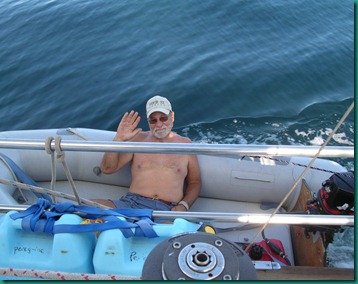 You can see the flat seas! Calm enough to stand up in the dinghy!
You can see the flat seas! Calm enough to stand up in the dinghy!
In all fairness, we didn’t make up this idea of using the dinghy. Mangareva had actually done this to get themselves into San Blas a few weeks earlier. Their story got out into the cruiser world somehow, and it was rattling around in our brains when we were faced with a similar situation. It always pays to pay attention!
Chapter 3
Now we called Roger and Jean Wise of Wise Marine Services. You haven’t heard me speak of them since last year since they live and work year-round in La Paz, and we have been other places. They were able to come help us, but not until Sunday. There are several thriving gringo cruiser businesses in La Paz that are fully booked, and Wise Marine is one of them. And with good reason. First, Roger coached Larry by phone to check several things. This gave him a good idea of what to expect. When he arrived on Sunday, he tracked down the problem fairly quickly. It was a blockage at a 90-degree fitting in the exhaust line. Apparently this is a fitting in a line that gets blocked like this fairly regularly. We were probably fortunate that we had not experienced this problem earlier. We had the heat exchanger boiled out back in Mazatlan in January, but the problem here was in a fitting that isn’t removed and cleaned with that job. The fitting can easily crack and must be welded back in place. Roger cleaned it out with a snake and a coat hanger!
After the boat was fixed, we treated them to a nice lunch at the restaurant and checked the weather. Tomorrow looked good. In fact, between Saturday (yesterday) and Tuesday, Monday was the best of all days for our return.
We left the anchorage at 6:00 am and motored around to La Paz on flat seas with an engine that never topped 170 degrees F. (The acceptable operating temperature range is 160-190.)
No problems with the weather on this passage:
During this passage, we ran the macerators for the holding tanks. This is a task usually better left unmentioned, but in this instance we were doing it for the first time for the aft head. Larry had only completed the macerator installation project for the aft holding tank during our most recent stay in Mazatlan. When he ran it during today’s passage, he discovered two pinholes in the brand new discharge hose! They sprayed raw sewage (eeuuww!) into the bilge of the engine room, and it really, really stank up the place! (I hope that’s a word – stank!) So Larry got the happy job of cutting the hose and retightening the hose clamps – yuck!! He earned LOTS of brownie points today! And, of course, it was warm outside so it was HOT in the engine room. Brutal!
And so, on Monday, March 21, we finally arrived in La Paz after leaving Mazatlan on Saturday, March 12. Nine days for our two-day crossing! But we were always safe with options thought about in advance or immediately evident. Cruisers like to say that Attitude is the difference between an Ordeal and an Adventure. We feel strongly that we had a great adventure, and hope that you have enjoyed sharing it with us.
Epilogue
We spent a couple of days in La Paz at anchor and researched and discussed at length our options for leaving Peregrine in La Paz. We had lost a week and needed to get home. Larry’s mom has had another high blood-pressure episode, and Muggs’ efforts to find work are beginning to finally pay off. We didn’t have time to continue on to Puerto Escondido where we had planned to leave the boat in the water on a mooring ball in a great hurricane hole.
The decision was made quickly to put the boat in Singlar which runs a very nice marina at the south end of La Paz Bay. The water down there is very shallow, so they send a guide boat to escort you in. We have been here since last Thursday, March 24.
There is a lot of work involved in leaving a boat behind in the tropics for the summer, but I will not bore you with the details. Suffice it to say, the excitement and fun stories are over for a while. I will update occasionally, especially this spring as we figure out exactly what our plans are regarding boating and work for the next few months. But posts will be fewer and farther between. I only plan to work for one or two years. This has all cost more than planned, and we left a little prematurely in the first place, so the piper must be paid. When we return back to the boat in the near future, the blog posts will return. Thank you for coming with us on these travels and sharing the joy!
Skipper Larry and Admiral Muggs
